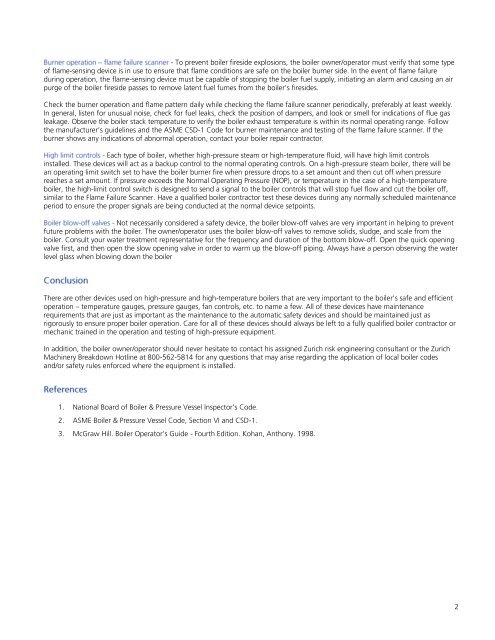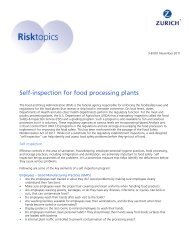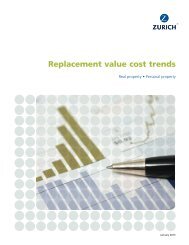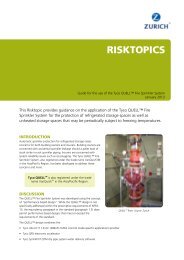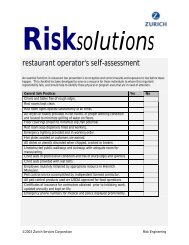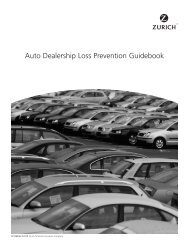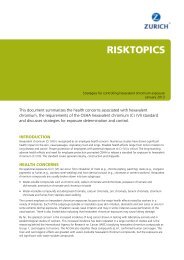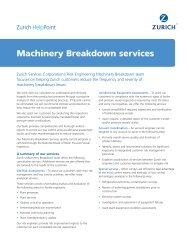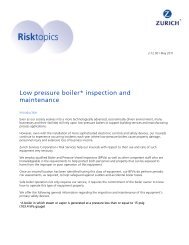high pressure boiler inspection and maintenance - Risk Engineering
high pressure boiler inspection and maintenance - Risk Engineering
high pressure boiler inspection and maintenance - Risk Engineering
Create successful ePaper yourself
Turn your PDF publications into a flip-book with our unique Google optimized e-Paper software.
- To prevent <strong>boiler</strong> fireside explosions, the <strong>boiler</strong> owner/operator must verify that some typeof flame-sensing device is in use to ensure that flame conditions are safe on the <strong>boiler</strong> burner side. In the event of flame failureduring operation, the flame-sensing device must be capable of stopping the <strong>boiler</strong> fuel supply, initiating an alarm <strong>and</strong> causing an airpurge of the <strong>boiler</strong> fireside passes to remove latent fuel fumes from the <strong>boiler</strong>'s firesides.Check the burner operation <strong>and</strong> flame pattern daily while checking the flame failure scanner periodically, preferably at least weekly.In general, listen for unusual noise, check for fuel leaks, check the position of dampers, <strong>and</strong> look or smell for indications of flue gasleakage. Observe the <strong>boiler</strong> stack temperature to verify the <strong>boiler</strong> exhaust temperature is within its normal operating range. Followthe manufacturer’s guidelines <strong>and</strong> the ASME CSD-1 Code for burner <strong>maintenance</strong> <strong>and</strong> testing of the flame failure scanner. If theburner shows any indications of abnormal operation, contact your <strong>boiler</strong> repair contractor.Each type of <strong>boiler</strong>, whether <strong>high</strong>-<strong>pressure</strong> steam or <strong>high</strong>-temperature fluid, will have <strong>high</strong> limit controlsinstalled. These devices will act as a backup control to the normal operating controls. On a <strong>high</strong>-<strong>pressure</strong> steam <strong>boiler</strong>, there will bean operating limit switch set to have the <strong>boiler</strong> burner fire when <strong>pressure</strong> drops to a set amount <strong>and</strong> then cut off when <strong>pressure</strong>reaches a set amount. If <strong>pressure</strong> exceeds the Normal Operating Pressure (NOP), or temperature in the case of a <strong>high</strong>-temperature<strong>boiler</strong>, the <strong>high</strong>-limit control switch is designed to send a signal to the <strong>boiler</strong> controls that will stop fuel flow <strong>and</strong> cut the <strong>boiler</strong> off,similar to the Flame Failure Scanner. Have a qualified <strong>boiler</strong> contractor test these devices during any normally scheduled <strong>maintenance</strong>period to ensure the proper signals are being conducted at the normal device setpoints.Not necessarily considered a safety device, the <strong>boiler</strong> blow-off valves are very important in helping to preventfuture problems with the <strong>boiler</strong>. The owner/operator uses the <strong>boiler</strong> blow-off valves to remove solids, sludge, <strong>and</strong> scale from the<strong>boiler</strong>. Consult your water treatment representative for the frequency <strong>and</strong> duration of the bottom blow-off. Open the quick openingvalve first, <strong>and</strong> then open the slow opening valve in order to warm up the blow-off piping. Always have a person observing the waterlevel glass when blowing down the <strong>boiler</strong>There are other devices used on <strong>high</strong>-<strong>pressure</strong> <strong>and</strong> <strong>high</strong>-temperature <strong>boiler</strong>s that are very important to the <strong>boiler</strong>'s safe <strong>and</strong> efficientoperation – temperature gauges, <strong>pressure</strong> gauges, fan controls, etc. to name a few. All of these devices have <strong>maintenance</strong>requirements that are just as important as the <strong>maintenance</strong> to the automatic safety devices <strong>and</strong> should be maintained just asrigorously to ensure proper <strong>boiler</strong> operation. Care for all of these devices should always be left to a fully qualified <strong>boiler</strong> contractor ormechanic trained in the operation <strong>and</strong> testing of <strong>high</strong>-<strong>pressure</strong> equipment.In addition, the <strong>boiler</strong> owner/operator should never hesitate to contact his assigned Zurich risk engineering consultant or the ZurichMachinery Breakdown Hotline at 800-562-5814 for any questions that may arise regarding the application of local <strong>boiler</strong> codes<strong>and</strong>/or safety rules enforced where the equipment is installed.1. National Board of Boiler & Pressure Vessel Inspector’s Code.2. ASME Boiler & Pressure Vessel Code, Section VI <strong>and</strong> CSD-1.3. McGraw Hill. Boiler Operator's Guide - Fourth Edition. Kohan, Anthony. 1998.2


